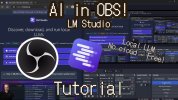- Supported Bit Versions
-
- 64-bit
- Source Code URL
- https://github.com/royshil/obs-urlsource
- Minimum OBS Studio Version
- 29.0.0
- Supported Platforms
-
- Windows
- Mac OS X
- Linux
The URL/API Source plugin adds a video source that fetches data from a URL / API endpoint or a local file and displays it as formatted text (HTML, CSS), Image and even Audio. You can build dynamic requests, including sending an image, parse output as JSON, XML, HTML and also plain text response body with a Regex to get just the information you need. Set up a timer to keep refreshing the data to get that live feed effect.
Sponsor my work https://github.com/sponsors/royshil
For support please submit issues on https://github.com/royshil/obs-urlsource/issues



(YouTube Tutorial) (New Features Tutorial) (HTML Scraping tutorial)
Additional things to do with URL/API source to upgrade your content:
Features:
The internal template renderer supports HTML4 and CSS with a reduced subset of features (https://doc.qt.io/qt-6/richtext-html-subset.html). It is quite powerful and can render tables and apply various styling to the text.
Image render is supported with the `<img />` tag, and external URLs are supported as well. For example, `<img src="{{output}}" />` could be used to dynamically render an image URL coming from the response.
Walkthrough
of the plugin code with highlights of its internal workings:

(YouTube Code Walkthrough)
Sponsor my work https://github.com/sponsors/royshil
For support please submit issues on https://github.com/royshil/obs-urlsource/issues
(YouTube Tutorial) (New Features Tutorial) (HTML Scraping tutorial)
Additional things to do with URL/API source to upgrade your content:
- HTML live website Scraping (18 min)
- Use ChatGPT
- Live Narration of your content with GPT
- Text-to-Speech with Coqui
- Live data from Google Sheets with API
- Send captions to YouTube API
- Get VSCode live data with API
- Translate with DeepL API
Inspiration
Out of ideas on what to do with URL/API Source? Here's a repo with 1,000s of public APIs https://github.com/public-apis/public-apisFeatures:
- HTTP request types: GET, POST
- Request headers (for e.g. API Key or Auth token)
- Request body for POST
- Dynamic input from a Text or Image source (base64)
- Output parsing: JSON via JSONPointer & JSONPath, XML/HTML via XPath & XQuery, Regex and CSS selectors
- Update timer for live updating data
- Test of the request to find the right parsing
- Output styling (font, color, etc.) and formatting (via regex post processing)
- Output Image (via image URL or image data on the response)
- Output text to external Text Source
- Output audio to external Media Source
- Output to multiple sources with one request (Output Mapping)
- Output to source settings for usage in automations (adv-SS, websocket, etc.)
- Multi-value (array, union) parsed output capture, object unpacking (via Inja)
- Dynamic input aggregations (time-based, "empty"-based)
- Websocket support
- Authentication (Basic, Digest, OAuth)
- More parsing options (CSV, etc.)
- More request types (HTTP PUT / DELETE / PATCH, and GraphQL)
- More output formats (Markdown, slim, reStructured, HAML, etc.)
- Video output
The internal template renderer supports HTML4 and CSS with a reduced subset of features (https://doc.qt.io/qt-6/richtext-html-subset.html). It is quite powerful and can render tables and apply various styling to the text.
Image render is supported with the `<img />` tag, and external URLs are supported as well. For example, `<img src="{{output}}" />` could be used to dynamically render an image URL coming from the response.
Walkthrough
of the plugin code with highlights of its internal workings:
(YouTube Code Walkthrough)




